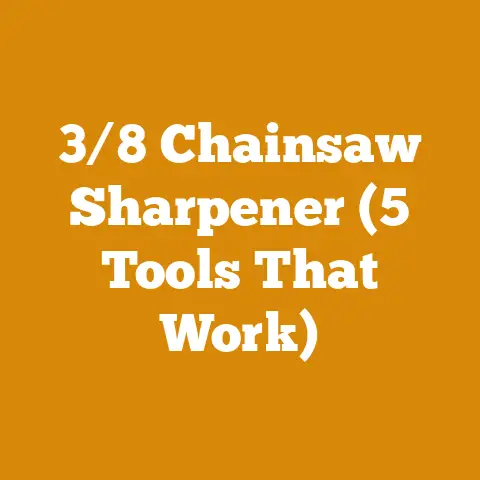Stihl MS 211C Chain (5 Maintenance Tips)
Easy Installation of Stihl MS 211C Chain
Changing the chain on your Stihl MS 211C might seem daunting at first, but once you get the hang of it, it’s as easy as pie. I remember my first time trying it—I was all thumbs! But with a little patience, I learned the ropes, and so can you.
Prerequisites and Required Materials
Before you start tinkering with your chainsaw, make sure you’re equipped with the essentials:
- New Stihl MS 211C Chain: Always use the chain recommended by Stihl to maintain performance.
- Protective Gloves: These are a must to protect your hands from sharp edges.
- Screwdriver or Scrench: Essential for removing the bar cover. A scrench, if you’re unfamiliar, is a tool combining a screwdriver and wrench—super handy!
- Clean Cloth: For wiping down dirt and debris.
- Safety Glasses: Trust me, you don’t want sawdust in your eyes.
5 Maintenance Tips for the Stihl MS 211C Chain
Tip 1: Regular Cleaning
Chainsaws get dirty—fast. Sawdust, oil, and grime can gunk up your chainsaw’s performance if not cleaned regularly. I usually give mine a thorough clean after each use. Here’s how:
- Remove the Chain: First, ensure the saw is off and cooled down. Use your screwdriver or scrench to remove the bar cover.
- Wipe Down All Parts: Use your clean cloth to wipe down the chain, bar, and body of the saw. A clean tool is a happy tool!
- Inspect for Wear: While cleaning, keep an eye out for any wear or damage to the chain or bar. This is your chance to catch potential issues before they become big problems.
Cleaning not only keeps your chainsaw running smoothly but also extends its lifespan. I once neglected this step and paid for it with a dull chain and sluggish performance.
Tip 2: Lubricate the Chain
Lubrication is like giving your chainsaw a drink of water—it needs it to function properly. Without proper lubrication, friction can wear down the chain and bar quickly.
- Check the Oil Level: Before each use, make sure your chainsaw has enough bar oil. If you’re like me and sometimes forget, try setting a reminder on your phone.
- Manual Lubrication: If needed, you can manually apply oil along the chain. I keep a small bottle of oil in my toolbox just in case.
Keeping the chain well-oiled minimizes friction and prevents overheating—a lesson I learned the hard way when my chain got stuck mid-cut on a hot summer day.
Tip 3: Proper Tension Adjustment
A properly tensioned chain is crucial for both safety and efficiency. Too loose, and it might fly off; too tight, and it could damage the bar.
- Regularly Check Tension: After turning off the saw and letting it cool down, pull the chain away from the bar; it should snap back easily.
- Adjust as Needed: Use your scrench to adjust the tension screws if necessary.
I like to check tension every time I use my chainsaw—it takes just a minute but can save you from bigger headaches later on.
Tip 4: Sharpening the Chain
A sharp chain makes all the difference in cutting efficiency and safety. Dull chains require more force and can lead to accidents.
- Use a File Guide: Follow Stihl’s instructions for angle and depth when sharpening. A file guide helps maintain consistency.
- File Each Tooth Evenly: Work your way around the chain patiently—each tooth deserves attention.
Regular sharpening has saved me countless hours of frustration in the woods. Once, I had to stop mid-job because I’d forgotten to sharpen my chain—the extra effort required was no joke!
Tip 5: Inspect for Damage
Routine inspections help catch issues before they become major problems.
- Look for Cracks or Breaks: Carefully inspect each link for signs of damage.
- Replace if Needed: If you spot any damage, replace the chain immediately.
Inspecting my chainsaw regularly has helped me avoid costly repairs—and kept me safe. Once, I noticed a small crack just in time before embarking on a big project.
Safety Precautions
Safety should always come first when working with chainsaws:
- Wear Protective Gear: Gloves and safety glasses are non-negotiable.
- Disconnect Spark Plug: Before performing maintenance, ensure the chainsaw is off and unplugged.
- Avoid Loose Clothing: It can get caught in moving parts easily.
I’ve had close calls due to loose clothing—now I make sure everything is tucked in before starting up.
Troubleshooting Tips
Even with meticulous care, issues can arise. Here are some common problems and how to troubleshoot them:
Chain Keeps Getting Loose?
- Check Tension Regularly: Adjust as needed—sometimes temperature changes can affect tension.
- Inspect Bar Nuts: Ensure they are tight; loose nuts can lead to a loose chain.
I remember a frustrating morning when my chain kept slipping off—turns out it was just a loose bar nut!
Chain Not Cutting Properly?
- Sharpen the Chain: A dull chain won’t cut efficiently.
- Check Chain Direction: Ensure it’s installed correctly—sounds silly but happens more often than you’d think!
Common Questions & Concerns
Let’s address some common questions folks have about maintaining their Stihl MS 211C:
How often should I replace my chain?
It depends on usage—frequent users may need to replace their chains more often than occasional users. Personally, I replace mine when it shows signs of wear or damage.
Can I use non-Stihl chains?
While some aftermarket options exist, it’s best to stick with Stihl chains for guaranteed compatibility and performance.
Final Thoughts
Chainsaw maintenance is about consistency and care. Following these tips will keep your Stihl MS 211C running smoothly and safely for years to come—saving you time, money, and frustration.
FAQ
Q: How do I know if my chain is properly tensioned?
A: The chain should snap back when pulled away from the bar but not be excessively tight.
Q: What type of oil should I use for lubrication?
A: Use bar and chain oil specifically designed for chainsaws for optimal performance.
Q: How do I safely dispose of an old chain?
A: Check local recycling guidelines; many places accept metal chains.
Remember, if you ever feel unsure about maintaining or using your chainsaw safely, don’t hesitate to consult with a professional or reach out for help!






